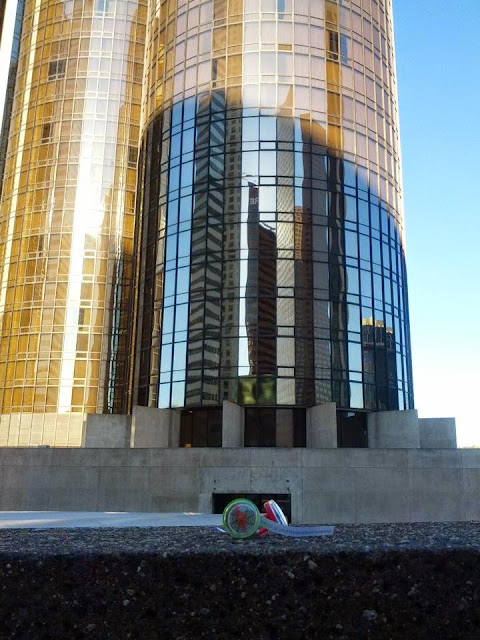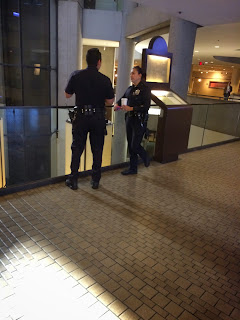
Gaming the Bonaventure
A FUN AND FURIOUS GAME FOR ASA 2014//LOS ANGELES//CALIFORNIA
How To Play
Friday November 7th, 2014, 8:00-9:45 am, Level 1 Santa Barbara C
Objective: Get lost and found in the Bonaventure Hotel.
What you need: The photos on this website, a digital camera, tokens
Instructions:
Locate and recreate as many of the photos as possible before time runs out. You have 30 minutes.
Leave a token at each location. Document it and any other tokens already there.
Avoid security.
Return to meeting room and compare and discuss photos. PRIZES!
* * *
What you need: The photos on this website, a digital camera, tokens
Instructions:
Locate and recreate as many of the photos as possible before time runs out. You have 30 minutes.
Leave a token at each location. Document it and any other tokens already there.
Avoid security.
Return to meeting room and compare and discuss photos. PRIZES!
1.
“The only way you can understand the nature of the argument that Jameson and others have developed over the years, is to actually move in, and move around, the Bonaventure Hotel. It’s a landscape that is highly fragmented, it’s a space that de-centers you, makes you feel lost, and, in this feeling of being lost, dislocated, you feel that your only recourse is to submit to authority.” ~Edward Soja
3 points
2.
“Most of the entrances are fly-over and walkways in the sky connected to other parts of the postmodern downtown of Los Angeles where one gets equally lost trying to move around.”~Edward Soja
1 point
3.
"The Bonaventure aspires to being a total space, a complete world, a kind of miniature city; to this new total space, meanwhile, corresponds a new collective practice, a new mode in which individuals move and congregate, something like the practice of a new and historically original hypercrowd…it does not wish to be a part of the city but rather its equivalent and replacement or substitute.”~Fredric Jameson
3 points
4.
“The descent is dramatic enough, plummeting back down through the roof to splash down in the lake. What happens when you get there is something else, which can only be characterized as milling confusion, something like the vengeance this space takes on those who seek to walk through it.”~Fredric Jameson
3 points
5.
“Some have argued that the Bonaventure has become a concentrated representation of the restructured spatiality of the late capitalist city: fragmented and fragmenting, homogenous and homogenizing, divertingly packaged yet curiously incomprehensible, seemingly open in presenting itself to view but constantly pressing to enclose, to compartmentalize, to circumscribe, to incarcerate”~Edward Soja
1 point
6.
“Screaming for attention, with its shining circular turrets of bronzed glass, the amazingly storied Bonaventure reflects the splintered labrinth that stretches for sixty miles around it”~Edward Soja
1 point
7.
“There were stories of shops being forced to close because they were located at levels of the four almost identical circular towers that no customers could find. Public complaints abounded about the concrete bunkers that blocked the hotel at ground level, forcing entry via floating skywalks to nowhere. The Bonaventure became a sounding board for all that was wrong—yet provocative—with Los Angeles”~Edward Soja
5 points
8.
“Your helpless, you’re made helpless, you’re peripheralized, you’re lost in these spaces. And the way you accommodate yourself to them, and the way you survive in them is essentially to submit to forms of overseeing, social control, authority; often invisible, by the way, because part of being lost is that even when you’re willing to submit to authority you can’t find it”~Edward Soja
5 points
9.
“It has been obvious since the opening of the hotel in 1977 that nobody could ever find any of these stores, and even if you once located the appropriate boutique, you would be most unlikely to be as fortunate a second time; as a consequence, the commercial tenants are in despair and all the merchandise is marked down to bargain prices. When you recall that Portman is a businessman as well as an architect and a millionaire developer, an artist who is at one and the same time a capitalist in his own right, one cannot but feel that here too something of a ‘return of the repressed’ is involved.”~Fredric Jameson
3 points
10.
"In Portman therefore, reference—the traditional room, the traditional language and category—is brutally disassociated from the newer postmodern space of the euphoric central lobby and left to etiolate and dangle slowly in the wind.”~Fredric Jameson
1 point
11.
“There are lots of things even within this microcosm, the Bonaventure Hotel, that are attractive, enjoyable, super modern, ultra clean, and, indeed sometimes, ultra engaging. You see this inside the Bonaventure, and outside a kind of complex mirror reflection of the very nature of postmodern society and postmodern experience.”~Edward Soja
3 points
12.
“This latest mutation in space—postmodern hyperspace—has finally succeeded in transcending the capacities of the individual human body to locate itself, to organize its immediate surroundings perceptually, and cognitively to map its position in a mappable external world…. This alarming disjunction point between the body and its built environment...can itself stand as the symbol and analogon of that even sharper dilemma which is the incapacity of our minds, at least at present, to map the great global multinational and decentered communication networks in which we find ourselves caught as individual subjects.”~Fredric Jameson
3 points
About Gaming the Bonaventure
Twenty-five years ago geographer Edward Soja published
Postmodern Geographies, a bold assertion of the spatial turn in geography. He
argued that "it all comes together in Los Angeles." Soja claimed that
global economic trends, the internationalization of finance and human resources
of "late capitalism," had combined to produce downtown L.A. in its
own image—a fragmented, segregated, defended, privatized space facing inwards,
turning its back on the streets and diverse peoples of the urban area. In
addition to Soja, Mike Davis and Fred Jameson published contemporary
interventions into debates about American cities, capitalism and postmodernism.
Their work shaped significant academic debates around architecture and the
organization of space in the 1990s. For these writers, L.A.'s Westin
Bonaventure Hotel, built between 1974 and 1976, was "a concentrated
representation of the restructured spatiality of the late capitalist city"
(Soja). Seeing the Bonaventure as carceral, dislocating, confusing and
demanding submission to an unseen authority, Jameson, Davis and Soja each made
of the hotel a nightmarish, yet theoretically seductive, icon of a dehumanizing
postmodernity.
Gaming the Bonaventure re-imagines the meanings of the Bonaventure Hotel. Using this foundational scholarship and contemporary photographs of the hotel as a jumping off point, Gaming the Bonaventure engages in a playful exploration of the hotel and its environs. The game stages a real-time exploration of the Bonaventure, confronting the architectural and structural aspects of the hotel so roundly criticized in the literature of the 1990s and revisiting the politics of dislocation and disorientation in the present as a gaming strategy. Gaming the Bonaventure suggests that enacting transgressive flanerie, producing speculative geography, or otherwise "gaming" a space, engages profoundly with the dialectics of pleasure and pain at the heart of capitalism (early and late), and shows how the Westin Bonaventure in downtown L.A. is a pivotal site for analyzing "the fun and the fury" where urban studies and game studies intersect.
Credits:
Aubrey Anable teaches digital media and game studies at the
University of Toronto. She is currently working on a book about video games and
affect. Playing With Feelings engages with game studies, digital media studies,
and theories of affect to provide an account of how video games compel us to
play and how they constitute a contemporary structure of feeling emerging from
and alongside the last sixty-plus years of computerized living. Anable’s
articles have appeared in the journals Afterimage, Television & New Media, Mediascape,
Ada, and Social Text Blog. She has also contributed to the collection Game On,
Hollywood! Essays on the Intersection of Video Games and Cinema (McFarland,
2013) as well as The Encyclopedia of Video Games (Greenwood, 2012). Her essay on
mobile gaming and the contemporary rhythms and measurement of labor and leisure
is included in Contemporalities: Keywords for the Present (forthcoming, NYU
Press).
Art Blake is Associate Professor in the Department of
History at Ryerson University, Toronto, and Faculty Lead on the
"CanadianCity" university-community initiative in the Faculty of
Arts. He received his B.A. in American Studies from the University of Sussex
and his Ph.D. in History from American University, Washington, D.C. Blake
specializes in U.S. 20th-century urban and cultural history and sound studies.
Originally Angela M. Blake, he transitioned in 2011 and is now Art M. Blake.
His first book, How New York Became American, 1890-1924 (2006) examined the
place of New York City in the American national imagination in the first two
decades of the 20th century and the role of the tourist industry in remaking
the city’s image. Blake is currently completing a book project, Talk To Me:
Culture and Politics of the Heard Voice in Postwar America, examining the
histories of gendered, racialized and digitized voices and the technologies
through which they were communicated. Recent publications related to this
project include “An Audible Sense of Order: Race, Fear, and CB Radio on Los
Angeles Freeways in the 1970s,” in Sound in the Age of Mechanical Reproduction,
eds. David Suisman and Susan Strasser (2009) and "Audible Citizenship and
Audiomobility: Race, Technology and CB Radio," American Quarterly, 63:3,
2011. Blake's research has been supported by fellowships and grants from the
Smithsonian Institution, Harvard University, the Library of Congress, and most
recently by the Social Science and Humanities Research Council (SSHRC) of
Canada. Blake's new research combines games studies and urban studies.
Erik Knutzen is an avid tinkerer, vegetable gardener,
beekeeper and backyard poultry wrangler. He is the co-author, with
his wife, Kelly Coyne, of The Urban Homestead (Process Media, 2008) and Making
It: Radical Home Ec for a Post Consumer World (Rodale, 2011). They
also maintain the blog Root Simple,
in which they use the rubric of “urban homesteading” to advocate for creative
interventions into the landscape of Los Angeles, reclaiming curbsides, medians,
bicycle lanes, and disused land in the service of local communities. Knutzen
was one of the founding members of PeopleMover,
a creative intervention into discourses around public transportation in
Southern California in the 1990s. He remains active in issues of transportation
in Los Angeles, lobbying for increased use of alternative modes of
transportation, and organizing walking and bicycling tours that feature
alternate histories of the city.
Nic Sammond is an Associate Professor and Graduate
Coordinator in the Cinema Studies Institute at the University of Toronto and
author of Babes in Tomorrowland: Walt Disney and the Making of the American
Child, 1930-1960 (Duke 2005). He has published widely on media and social
practice, including “Walt Disney’s Dumbo: Governing Individualism,” in The
Oxford Handbook of Children’s Literature (Oxford 2011), “Hidden, or Fear of a
Black Planet.” Jump Cut 52 (Summer 2010), “Gentlemen, Please Be Seated: Racial
Masquerade and Sadomasochism in 1930s Animation.” in Burnt Cork: Traditions and
Legacies of Blackface Minstrelsy (University of Massachusetts Press, 2012), and
“The Writing on the Wall: Learning and Teaching Graffiti,” with Anna Creadick. Transformations,
forthcoming. His next book is Biting the Invisible Hand: Blackface Minstrelsy
and the Industrialization of American Animation (Duke, in press). He is
currently working on two projects that involve a critical intervention into
media-archaeological conceptions of the hive and the swarm. One, examines an
outbreak of intermedial mass conversion disorder amongst teen-aged women in
LeRoy, New York. The other engages with incidents, such as those in Steubenville,
Ohio and Maryville, Missouri, in which social media were used to perpetrate and
celebrate sexual assaults, then subsequently mobilized in a quest for popular
justice in those cases.
Subscribe to:
Posts
(
Atom
)




















